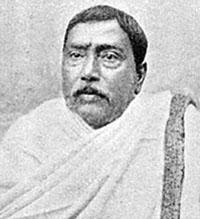 W
WThe Bengal Renaissance, also known as the Bengali Renaissance, was a cultural, social, intellectual, and artistic movement that took place in the Bengal region of the British Raj, from the late 18th century to the early 20th century. Historians have traced the beginnings of the movement to the victory of the British East India Company at the 1757 Battle of Plassey, as well as the works of reformer Raja Rammohan Roy, considered the "Father of the Bengal Renaissance," born in 1772. Nitish Sengupta stated that the movement "can be said to have … ended with Rabindranath Tagore," Asia's first Nobel laureate.
 W
WBaba Lokenath Brahmachari was a Bengali spiritual master and yogi, considered to be one of the most influential gurus of oriental philosophy.
 W
WVishmadev Chattopadhyay was an eminent vocal artist in Indian Classical Music, a revered Guru in the Delhi Gharana of the vocal classical genre, and a music director in Bengali Film Industry in its early era.
 W
WDwarkanath Gangopadhyay was born on 20 April 1844 and died on 27 June 1898. Dwarkanath was a Brahmo reformer in Bengal of British India. He made substantial contribution towards the enlightenment of society and the emancipation of women. He dedicated his whole life for the cause of women emancipation and encouraged them to participate in every walk of life be it politics, social services etc and even helped them to form organizations of their own. He was the husband of the first Indian practising lady doctor, Kadambini Ganguly.
 W
WThe Freedom of Intellect Movement was a Bengal Renaissance movement advocating rationality against religious and social dogma in Bengali Muslim society. It was spearheaded by intellectuals in the University of Dhaka during the British Raj.
 W
WThe indigo revolt was a peasant movement and subsequent uprising of indigo farmers against the indigo planters that arose in Chaugacha village of Nadia in Bengal in 1859.
 W
WDilip Kumar Roy, also spelt Dilipkumar Roy, was an Indian musician, musicologist, novelist, poet, essayist and yogi. He was the son of Dwijendralal Ray. In 1965, the Sangeet Natak Akademi, India's National Academy for Music, Dance and Drama, awarded him its highest honour for lifetime achievement, the Sangeet Natak Akademi Fellowship.
 W
WRaja Ram Mohan Roy was an Indian reformer who was one of the founders of the Brahmo Sabha, the precursor of the Brahmo Samaj, a social-religious reform movement in the Indian subcontinent. He was given the title of Raja by Akbar II, the Mughal emperor. His influence was apparent in the fields of politics, public administration, education and religion. He was known for his efforts to abolish the practices of sati and child marriage. Roy is considered to be the "Father of the Bengal Renaissance" by many historians.
 W
WAtul Prasad Sen Bengali: অতুল প্রসাদ সেন was a Bengali composer, lyricist and singer, and also a lawyer, philanthropist, social worker, educationist and littérateur.
 W
WJaladhar Sen Bengali: জলধর সেন was a Bengali writer, poet, editor and also a philanthropist, traveler, social worker, educationist and littérateur. He was awarded with the title Ray Bahadur by the British Government.
 W
WSunayani Devi was an Indian painter born into the aristocratic Tagore family in Calcutta, West Bengal. She was a self taught artist, with no academic training in art. Inspired by her brothers, Abanindranath Tagore, Gaganendranath Tagore, and Samarendranath Tagore, she started painting only at the age of 30. She was married at the age of 12 to the grandson of Raja Ram Mohan Roy.